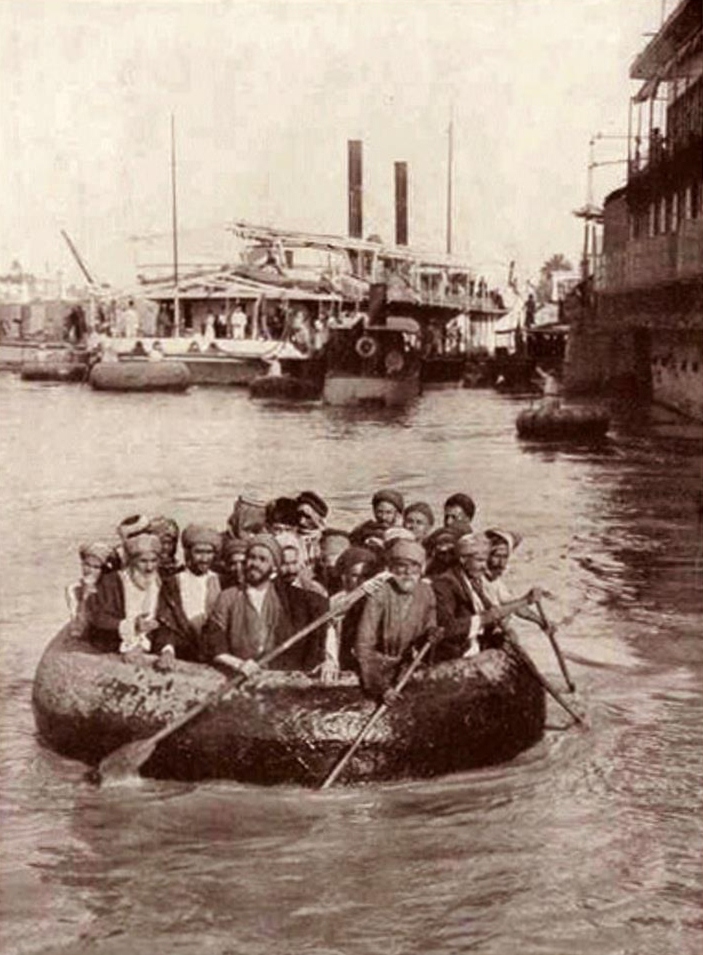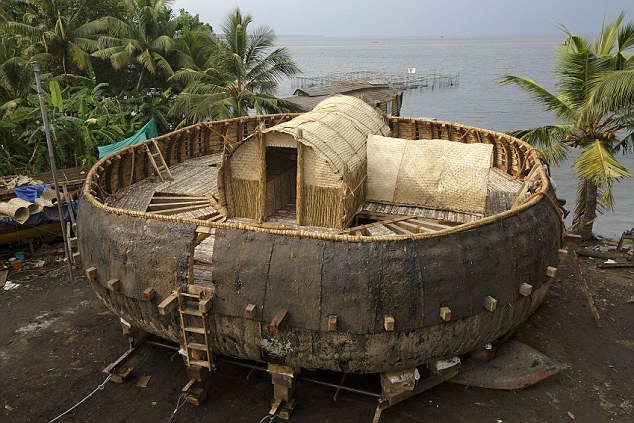The round boat called Quffa, used for transportation purposes, on a wall relief from the Assyrian period 2,700 years ago, and the boats used by Iraqis on the Tigris and Euphrates rivers in the 1920s.
Round boats are a fascination, and the quffa, a basket-built boat from Iraq, is among the most fascinating because of its well-documented antiquity, its common use well into the 20th century, and its sometimes very large — occasionally immense — size.

A quffa in Baghdad in 1914 (Source: Wikipedia) Click any image to enlarge.
Known also as a kuphar and by various alternate spellings, the quffa was described in the 5th century BCE by Herodotus, who stated that they were built in Armenia for one-way trading trips on the Euphrates. In his account, they were round, built of willow frames and covered with leather. The insides were protected by straw. They carried wooden casks of wine from Armenia to Babylon, along with at least one donkey and two paddlers. One paddler would pull from the front; the other would push from the rear. Upon reaching its destination, the boat was disassembled and the leather cover folded up, to be carried by the donkey on the road trip back home — the Euphrates being too swift for a return voyage.

Herodotus claimed that the largest quffas could carry 5,000 talents, which is thought to be about 125 tons. This seems a probable exaggeration, although there are sufficiently contemporary and sufficiently realistic local images of unquestionably large quffas, like this one, showing four oarsmen (not paddlers) rowing with a cargo of cut stone.
Alternate methods of construction were present in antiquity, including the method that remained common into modern times. As quoted by Peter Badge in Coracles of the World, James Hornell described it in “The Coracles of the Tigris and the Euphrates” (1938) as:
“…perfectly circular in plan, nearly flat bottomed, and with convexly curved sides that tumble-home to join the stout cylindrical gunwale bounding the mouth, which is several inches less in diameter than the width at mid height. In construction a quffa is just a huge lidless basket, strengthened within by innumerable ribs radiating from around the centre of the floor. The type of basketry employed is … coiled basketry.”
To continue the description of the basketry, Badge goes on to quote Dionysius A. Aguis:
“It consists of a spiral of reeds bundled and woven together…The reeds are woven together with a palm fibre rope and the basket is reinforced by an inner structure. Normally two quffa-builders are needed, one of the inside, and the other for the outside, as one passes the cord through the wall of the basket while the other tightens the cord….”
What’s not explained in either of these quotes is the quffa’s waterproofing. The exterior of the basket was covered with a layer of bitumen, of which there are high-grade deposits in Mesopotamia.

There is a cuneiform tablet from Babylon, dating to around 1750 BCE and discovered in the 1940s, but not translated until a few years ago, that describes a world-inundating flood in a clear precursor to the story of Noah. In this version, the god Enki cues a man name Atrahasis to the coming disaster and suggests he build a quffa to save himself. The tablet describes the boat in great detail, including its construction of reeds bound by ropes, its interior wood framing, its waterproof covering of bitumen to the thickness of a finger, and its size: a (literally) incredible 220 feet (67M) in diameter and 20 feet (6M) high with upper and lower levels.
The translator of the tablet, Irving Finkel of the British Museum, acknowledges that such a craft was physically impossible and doubtless the product of some mythologizing exaggeration. But he was so convinced of the basic soundness of the idea of a quffa large enough to serve as a model for the myth — one capable of supporting a family and livestock for a period — that he built a scaled-down version, which was launched in 2014. It too had two levels, with a deck house on the upper one and the lower one suitable for “lots of well-behaved animals.”
Replica Babylonian “deluge ark,” built under the direction of Irving Finkel. (Source: DailyMail.com)
Finkel’s 35-ton quffa leaked badly — due, he said, to using the low-grade bitumen available in Kerala, India, where the boat was built, rather than the higher-quality stuff from Iraq — but was stable and otherwise successful. Finkel concludes that such a craft might have actually been used and could have provided the basis for the deluge myth. A report about the project appears here.
Quffas remained in wide use on the Tigris and Euphrates Rivers, and especially around Baghdad, in the first half of the 20th century as water taxis, as carriers of produce and building materials, and as lighters. Various sources reported common sizes to be 4.5 ft to 10 ft. in diameter at the opening, with depths of 2.5 ft to 4 ft. The smallest was 3’8″ at the opening, and the largest 16’5″ with a maximum diameter of 18′. (Because of the quffa’s tumblehome, maximum diameters were regularly greater than the more easily-measured opening.) A large passenger quffa could carry 20 people.
In his definition of “coracle,” Peter Badge includes the ability to be carried by one man as one of the essential qualities of the type. Only the smallest quffas fit this description, so if one accepts Badge’s definition, most quffas can’t be considered a type of coracle. If one needs to place them in a category outside of themselves, “round basket boat” works, while “coracle-like craft” serves as a fair description.
Quffa use declined with the building of bridges and roads in Iraq and the proliferation of motor vehicles and launches. I believe they no longer serve an economic function, and do not know if any are being built for recreational purposes or even for the sake of historic preservation.
Related Post
A shocking documentary proves that mermaids do exist
SHOCKING Revelation: Thuya, Mother of Queen Tiye, Was the Grandmother of Akhenaten and Tutankhamun—What Ancient Egyptian Secrets Did She Leave Behind?
Breaking News: Astonishing Discoveries at Karahan Tepe Confirm an Extraterrestrial Civilization is Hiding on Earth, and NO ONE Knows!
Breaking News: Researchers FINALLY Discover U.S. Navy Flight 19 After 75 Years Lost in the Bermuda Triangle!
NASA’s Secret Investigation: Uncovering the Astonishing Mystery of the UFO Crash on the Mountain!
Explosive UFO Docs LEAKED: Startling Proof That Aliens Ruled Ancient Egypt!